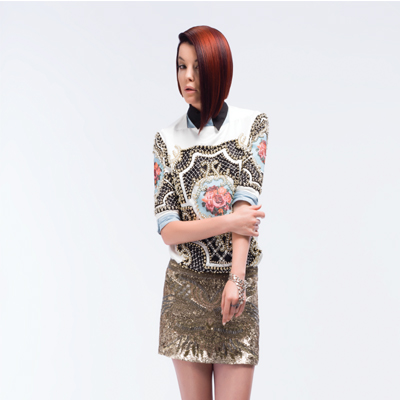Asymmetrical Bob from TONIandGUY













Below the horseshoe, take a central vertical parting. Take a horizontal section from below the occipital to the base of the ear. Comb the hair at the natural fall, elevate to one finger's depth and blunt-cut parallel to the part.

Advertisement














Advertisement














Advertisement














Advertisement














Advertisement






Asymmetrical Bob from TONIandGUY
Creative, wearable cuts you can create every day in your salon—that’s what the TONI&GUY Divert Collection is all about. This asymmetrical lob is fun, fresh, youthful and super trendy. Zak Mascolo and the TONI&GUY Artistic Team infuse anti-directional movement into this cut, giving it a ready-to-wear feel with an emphasis on modern versatility. But wait, there’s more! Zak is super excited to share with you some of TONI&GUY’s new franchising information for those who would like to own a TONI&GUY Salon!
Who did it
Cut: Zak Mascolo, Austin Finley, Joseph Marzioli
Haircolor: Jared Smith, Laura Pease, Samantha Finley
Styling: Caroline Mascolo
Makeup: Tommy Gomez
Photography: Alex Barron-Hough
On Paper Keyword: toniguy
TONI&GUY 2014: Back to Business, Back to Education, Back to Design!
A personal invitation from Bruno Mascolo!
Don’t miss Zak Mascolo on BT’C’s Cut & Style Stage at COLOR 2014!
For more information, visit www.toniguy.edu/franchising.
Want to learn how to create these looks? Purchase the DIVERT Collection DVD and technical manual in the BTC Bookstore!
Subscribe to behindthechair.com
On Paper Magazine! SUBSCRIBE NOW
HOW-TO STEPS 
-

 1
1Horizontal graduation will be utilized to build weight throughout the perimeter while the internal layering pattern is independently disconnected in order to create an anti-directional feel.
-

 2
2Take a profile parting from the center forehead to the center nape. From the top of the crown, take a diagonal forward parting to the mid-recession on both sides.
-

 3
3From the top of the parietal ridge, take a curved diagonal back horseshoe from below the crown.
-

 4
4Below the horseshoe, take a central vertical parting. Take a horizontal section from below the occipital to the base of the ear. Comb the hair at the natural fall, elevate to one finger’s depth and blunt-cut parallel to the part.
-

 5
5Take a second horizontal section from the occipital to the middle of the ear, combing the hair at the natural fall. Elevate at two fingers’ depth and blunt-cut parallel to the part.
-

 6
6Take a horseshoe section from above the occipital to mid-recession. From behind the ear, comb at the natural fall, elevate to three fingers’ depth, and cut parallel to the part.
-

 7
7In the front of the ear, transition your elevation to one fingers’ depth. Repeat on the opposite side.
-

 8
8Release the remaining hair, working with the same distribution and elevation. Blunt-cut the hair onto the underneath guideline.
-

 9
9Cross check the line for balance.
-

 10
10From the top of the crown, take a vertical section using the guide created by the graduation underneath. Elevate the hair 90° from the round of the head and slice parallel to the head shape.
-

 11
11Sub-divide the guide and continue by taking pivoting diagonal backs from the top of the crown, combing the hair into a T-part and overdirecting the hair to the stationary guideline.
-

 12
12Release the top triangular section and take a central vertical section from the top of the crown to the center forehead. Elevate the hair to 90° from the section and cut an independent guide square, disconnected from the previous layering.
-

 13
13Sub-divide the guide and comb the remainder of the hair into a T-part, overdirecting up to the central stationary guide in order to create a square inversion.
-

 14
14Utilizing a wrap technique, blow-dry with a small cushion brush.
-

 15
15Detail the base line by cleaning up any unwanted graduation with a wide-tooth comb.
-

 16
16Elevate the side panels at a low 45 degree angle from the face and point-cut a deep parallel line to create a visual balance.
-

 17
17Continue with soft surface channel cutting towards the face for separation.
-

 18
18 -

 19
19 -

 20
20 -

 21
21 -


YOU MIGHT LIKE THIS
-
Hair
Men’s Disconnected, Asymmetric Undercut from Zak Mascolo
-
Hair
Men’s Undercut from TONIandGUY’s Zak Mascolo
-
Hair
TONIandGUY Reflective Collection How-To: Britni
-
Barbering
Low Skin Fade On Textured Hair
-
Hair
TONIandGUY Reflective Collection Men’s How-To: Ryan


TRENDING NOW!
-
BTC Hair Trend Report
The Biggest Haircut Trends of 2024
-
Monthly Product Launch List
11 New Game-Changing Hair Launches To Add To Your Arsenal
-
Blonde
Conditioner Before Toner: Common Hair Myth Debunked
-
Copper
What Is The "Cowboy Copper" Hair Trend? Here's What It Really Means...
-
Frizz
Straighten & Smooth 2A, Fine-Medium Density Hair
-
Copper
Muted Bronze
-
Haircuts
SHAG 101: The Dos And Don'ts
-
BTC Hair Trend Report
WWYD: How Hairstylists Are Navigating Inflation




